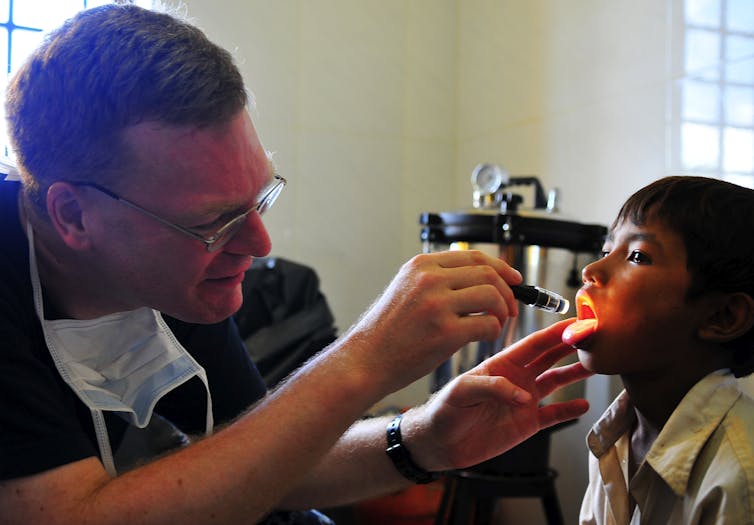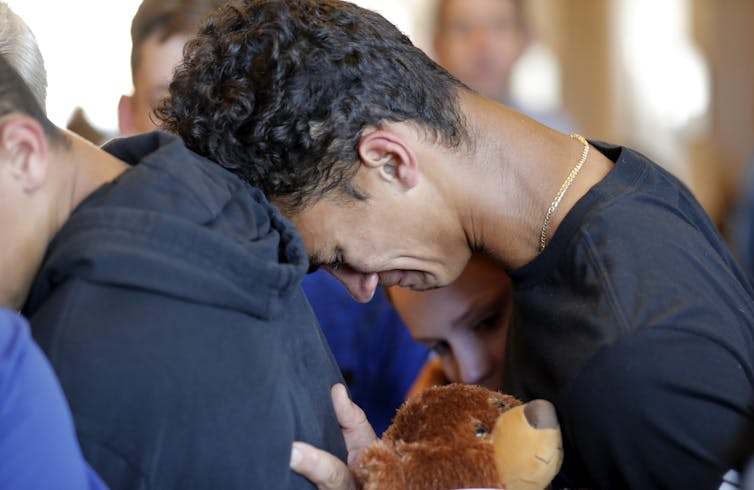Photo by Miami photojournalist Wilfredo Lee for AP accompanied this piece of the same title published by The Conversation published 2/16/18 by Elizabeth Englander (profile, email) Professor of Psychology, and the Director of the Massachusetts Aggression Reduction Center at Bridgewater State University.
The Conversation is a collaboration between editors and academics to provide news analysis and commentary that is free to read and republish using a Creative Commons, no derivatives licence.
*
After a shooter killed 17 people at a Florida high school, many have expressed frustration at the political hand-wringing over gun control and calls for prayer.
As a parent, I understand the desire for practical responses to school shootings. I also absolutely believe the government should do more to prevent such incidents. But the gun control debate has proven so divisive and ineffective that I am weary of waiting for politicians to act.
I study the kind of aggressive childhood behavior that often predates school shootings. That research suggests what communities and families can start doing today to better protect children. Here are 10 actions we can all take while the federal government drags its heels.
What schools can do
Because educators observe students’ emotional and behavioral development daily, they are best positioned to detect troubled behaviors and intervene. In Los Angeles, for example, schools have successfully used outreach and training to identify potentially violent students before problems occur.
1. Teach social and emotional skills
Children learn social skills from everyday interactions with each other. Playtime teaches young people how to control their emotions, recognize others’ feelings and to negotiate. Neighborhood “kick the can” games, for example, require cooperation to have fun – all without adult supervision.
Today, frequent social media use and a decrease in free play time has reduced children’s opportunities to learn these basic social skills.
But social and emotional skills can – and should – be taught in school as a way to prevent student violence. Students with more fluent social skills connect better with others and may be more able to recognize troubled peers who need help.
2. Hire more counselors and school resource officers
Due to budget cuts, many schools have few or no trained school psychologists, social workers or adjustment counselors on staff. These mental health professionals are society’s first line of defense against troubled students – especially with the current increase in adolescent depression and anxiety.
In my opinion, school resource officers – trained police officers who work with children – are also helpful for students. While untrained officers may pose a threat to students, well-trained school resource officers can connect with kids who have few other relationships, acting as a support system. They are also on hand to respond quickly if crime or violence erupts.
Putting trained school resource officers and counselors in every school will cost money, but I believe it will save lives.
3. Use technology to identify troubled students
Technology may challenge kids’ social development, but it can also be harnessed for good. Anonymous reporting systems – perhaps text-message based – can make it easier for parents and students to alert law enforcement and school counselors to kids who seem disconnected or disturbed. That enables early intervention.
In Steamboat Springs, Colorado, one such tip appeared to prevent extreme violence in May 2017. Police took a young man who’d threatened to harm his peers into protective custody before he could act on his words.
Technology may challenge kids’ social development, but it can also be harnessed for good. Anonymous reporting systems – perhaps text-message based – can make it easier for parents and students to alert law enforcement and school counselors to kids who seem disconnected or disturbed. That enables early intervention.
In Steamboat Springs, Colorado, one such tip appeared to prevent extreme violence in May 2017. Police took a young man who’d threatened to harm his peers into protective custody before he could act on his words.
What communities can do
Communities also help raise children. With many eyes and ears, they can detect often smaller problems before young people grow into violence.
4. Doctors should conduct standard mental health screenings
Extreme violence is almost always preceded by certain behavioral problems. These typically include a propensity toward aggression, a marked lack of social connectedness, indications of serious mental illness and a fascination with violence and guns.
Doctors could detect these problems early on with a standardized screening at health checkups. If concerns arise, referrals to counseling or other mental health professionals might follow.

Doctors are an underutilized community resource. Regular check-ups could help prevent violence. Myfuture.com, CC BY-ND
5. Enlist social media companies in the effort to detect threats
Most young people today use social media to express their feelings and aspirations. In the case of school shooters, these posts are often violent. A single violent post is hardly a guarantee of homicidal acts, of course. But evidence strongly indicates that repeated expressions of this nature can be a sign of trouble.
I would like to see companies like Instagram, Twitter and Snapchat create algorithms that identify repeated online threats and automatically alert local law enforcement.
What parents can do
Parents and guardians are often the first to detect their child’s emotional struggles. Here are some tips for monitoring and promoting healthy emotional development at home.
6. Think critically about your child’s social media use
From virtual war games to cruel trolls, the internet is full of violence. The relationship between violent content and aggression hasn’t been consistent in research: Some studies see no relationship at all, while others find some correlation between violent video games and violent behavior.
This mixed evidence suggests that online content affects children differently, so parents must assess how well their child handles it. If your daughter likes “Assassin’s Creed” but is gentle, socially successful and happy, the onscreen violence may not be strongly impacting her.
But if your child is drawn to violent games and tends to be aggressive or troubled, discuss the situation with your pediatrician or school counselor.
7. Consider what your child is missing out on
Is your child sleeping properly? Do your kids socialize with other young people? These two behaviors are linked to mental health in children, and excessive screen time can reduce or diminish the quality of both.
Make sure digital devices aren’t disrupting your kids’ sleep, and schedule play dates if your kids don’t make plans on their own.
8. Assess your child’s relationships
Like adults, children need confidants to feel invested in and connected with their community. The trusted person can be parent, a family member or a friend – just make sure someone’s playing that role.
For children who struggle to make friends and build relationships, there are programs that can help them learn how.

Children need confidants to feel connected to their communities. AP Photo/ by Louisiana-based Gerald Herbert
9. Fret productively about screen time
Research shows that excessive screen time can damage kids’ brains. That’s alarming in part because parents can’t realistically keep kids entirely off devices.
So rather than just fret over screen time, focus instead on how children can benefit from a variety of activities. Evidence shows that children who experience different pursuits over the course of their day – from sports and music to an after-school job – are happier and healthier for it.
10. Talk with your child
This is both the easiest and hardest way to make sure your kids are doing OK. Children, especially teenagers, don’t always want to talk about how life is going. Ask anyway.
My research shows that simply asking children about their friends, their technology use and their day is an important way to show you care. Even if they don’t respond, your interest demonstrates that you’re there for them.
 Try this one now. Ask your children what they’re thinking about the shooting in Florida and how they like their friends and school. Then listen.
Try this one now. Ask your children what they’re thinking about the shooting in Florida and how they like their friends and school. Then listen.

Children need confidants to feel connected to their communities. AP Photo/ by Louisiana-based Gerald Herbert
9. Fret productively about screen time
Research shows that excessive screen time can damage kids’ brains. That’s alarming in part because parents can’t realistically keep kids entirely off devices.
So rather than just fret over screen time, focus instead on how children can benefit from a variety of activities. Evidence shows that children who experience different pursuits over the course of their day – from sports and music to an after-school job – are happier and healthier for it.
10. Talk with your child
This is both the easiest and hardest way to make sure your kids are doing OK. Children, especially teenagers, don’t always want to talk about how life is going. Ask anyway.
My research shows that simply asking children about their friends, their technology use and their day is an important way to show you care. Even if they don’t respond, your interest demonstrates that you’re there for them.
 Try this one now. Ask your children what they’re thinking about the shooting in Florida and how they like their friends and school. Then listen.
Try this one now. Ask your children what they’re thinking about the shooting in Florida and how they like their friends and school. Then listen.